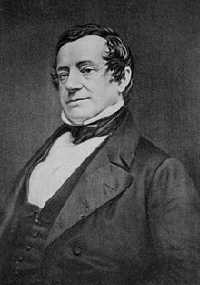 SKC Films Library |
| SKC Films Library >> American Literature >> 19th Century |
| Washington Irving establisher of the short story as an important literary form in America
Washington Irving was born in New York City, New York, on April 3, 1783, the youngest of 13 children. His father, William Irving, was a wealthy merchant who had emigrated to America from the Orkney Islands, and his mother, Sarah Sanders Irving, was the granddaughter of an English clergyman. His parents followed what at the time was a common custom and named their youngest child for the nation's first President, George Washington. He attended school until he was almost fifteen years old, travelled widely in Europe from 1804 to 1806, and then worked in law offices to study law. He was admitted to the New York bar in 1806, but his interest in the law was quickly overridden by a love for writing and he abandoned his practice in 1809. Irving's first published works were in the form of letters to the Morning Chronicle, a New York City paper edited by his brother Peter, in 1802 and 1803. The letters ridiculed New York society and made him famous among New Yorkers. From 1807 to 1808, he helped his brother William and James K. Pauling, William's brother-in-law, write satirical essays for their magazine Salmagundi. His first book, A History of New York from the Beginning of the World to the End of the Dutch Dynasty, a boisterous, satirical account of the state of New York from its earliest colonial days to Irving's day, was published in 1809. Popularly known as Knickerbocker's History of New York, the book was written under the pseudonym of Diedrich Knickerbocker, who was supposed to be an old, eccentric Dutch New Yorker. Although many New Yorkers were initially offended because it ridiculed their ancestors, the book became a beloved part of New York folklore, and the term "Knickerbocker" came to describe any New Yorker who could trace his/her history to the original Dutch settlers. Although Knickerbocker's made Irving famous, it was difficult for anyone to earn a good living as an author in the early 19th century so, in 1810, he elected to join the family's hardware business. He served as a military aide to New York Governor Daniel Tompkins during the War of 1812, and went to England in 1815 to run a branch of the family business there. The business failed in 1818, but Irving chose to stay in England and focus on his writing. While in England, he wrote The Sketch Book of Geoffrey Crayon, Gent. (1819-1820), a series of essays, stories, and other short pieces about the United States and England. Also known as The Sketch Book, it included his most famous stories, "Rip Van Winkle" and "The Legend of Sleepy Hollow." The book won him the respect of European critics and marked the acceptance of the short story as an important literary form in America. His follow-up work, Bainbridge Hall (1822), also emphasized British settings, but was less successful. Irving subsequently spent several years travelling around Europe, collecting folk tales along the way, and publishing Tales of a Traveller in 1824. From 1826 to 1829, he served as a U.S. diplomat in Spain, during which time he studied and wrote about Spanish themes. His most important works during this period were History of the Life and Voyages of Christopher Columbus (1828), The Conquest of Granada (1829), The Companions of Columbus (1831), and The Alhambra (1832), all based on careful historical research. In 1829, he joined the U.S. diplomatic staff in London. Irving returned to New York in 1832, and set out on a western tour later that same year. He described his trip in A Tour on the Prairies, the first in a series of books called The Crayon Miscellany (3 volumes, 1835). He then settled into Sunnyside, his estate in Tarrytown, New York, where he turned from fiction to history and biography. Appointed U.S. Minister to Spain in 1842, he served four years there before returning to Sunnyside, where he spent the test of his life. He died there on November 28, 1859, soon after completing the last volume of The Life of George Washington. His Major Works A History of New York
from the Beginning of the World to the End of the Dutch
Dynasty (1809) LINK OF INTEREST SEE ALSO |
| SKC Films Library >> American Literature >> 19th Century This page was last updated on 06/29/2018. |
